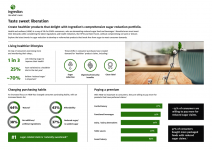Sugar-free confectionery moves to mainstream
sugar-free versions of traditional confectionery lines, which
suggests that sweeteners are no longer considered a 'niche'
ingredient in sweets, claims Beneo Palatinit.
Last month, the German-based company interviewed a random sample of 250 consumers in the country who were on the verge of buying a sugar-free confectionery product. According to the results, thirty per cent of the consumers eat sugar-free confectionery on a regular basis, and this figure would rise to a willing eighty per cent if popular ranges of sweets made with sugar were no longer available. "The creativity seen in the latest generation of sugar-free candies, and wide acceptance of sugar-free versions among consumers, show that we've come a long way since the first steps," said company spokesperson Claudia Meissner. "Today, sugar-free means lifestyle: Indulgent products with exciting flavours and functionalities are becoming the forerunners in the segment." When asked the reason behind the sugar-free choice, the main reasons were health and taste, chosen by 77 per cent and 67 per cent of consumers respectively. Furthermore, when asked about successful advertising claims, participants rated 'Original taste - no sugar', and 'Same taste without the sugar', as the most appealing. "This demonstrates that sugar-free candies have a convincing profile in terms of both nutrition and taste, and as such offer the opportunity to align indulgence with a healthy lifestyle - representing enormous market potential, Meissner said. Indeed, market analysis does appear to support Beneo Palatinit's claims, as figures from Mintel indicate that just over 34 per cent of UK consumers are now actively avoiding sugar, while in France and Germany, the figures are 40 per cent and 37 per cent respectively. Beneo Palatinit has shown itself to be eager to cash in on the trend in recent months, launching a variety of sugar-free sweeteners onto the European market. Last year, the company developed 'crush candies' made with the sweetener Isomalt. The sweets are manufactured using a similar process to normal hard-boiled sweets but cooled using liquid nitrogen, have small cracks below the surface. This gives them an unusual appearance and makes them collapse in the mouth in a peculiar way, releasing the flavour in bursts, the company claims. Isomalt, which is made from pure beet sugar, contains half the calories of sugar and has a low-glycaemic effect. According to Beneo-Palatinit, it is claimed to be the "most used" sugar replacement for sugar-free hard-boiled sweets, featured in around 1800 products worldwide. At the recent ISM trade show in Cologne, the company also showcased sugar-free confectionery with functional ingredients such as acai, lemon and 'chai latte'. Other companies across the European bloc are also busy launching sugar-free ingredients. For example, Tate & Lyle has developed a new sweetener solution for dairy desserts, which it claims allows manufacturers to cut around a third of calories and half of total sugars from their product formulations.




















